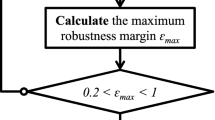Abstract
With a focus on an industrial multivariable system, two subsystems including the flow and the level outputs are analysed and controlled, which have applicability in both real and academic environments. In such a case, at first, each subsystem is distinctively represented by its model, since the outcomes point out that the chosen models have the same behavior as corresponding ones. Then, the industrial multivariable system and its presentation are achieved in line with the integration of these subsystems, since the interaction between them can not actually be ignored. To analyze the interaction presented, the Gershgorin bands need to be acquired, where the results are used to modify the system parameters to appropriate values. Subsequently, in the view of modeling results, the control concept in two different techniques including sequential loop closing control (SLCC) scheme and diagonal dominance control (DDC) schemes is proposed to implement on the system through the Profibus network, as long as the OPC (OLE for process control) server is utilized to communicate between the control schemes presented and the multivariable system. The real test scenarios are carried out and the corresponding outcomes in their present forms are acquired. In the same way, the proposed control schemes results are compared with each other, where the real consequences verify the validity of them in the field of the presented industrial multivariable system control.
Similar content being viewed by others
References
LEE S, YEOM S, LEE K S. Methods for performance monitoring and diagnosis of multivariable model-based control systems [J]. Korean Journal of Chemical Engineering, 2004, 21(3): 575–581.
OU-YANG C, JUAN Y. Applying process mining approach to support the verification of a multi-agent system [J]. Journal of Systems Science and Systems Engineering, 2010, 19(2): 131–149.
RUSANOV V A, DANEEV A V, KUMENKO A E, SHARPINSKIY D Y. On existence of non-stationary realization of a linear multivariable control system [C]// In Proc 19th International Conference on Systems Engineering. Las Vegas, 2008: 27–31.
SUN J, WANG S, FU Z. Process capability analysis and estimation scheme for autocorrelated data [J]. Journal of Systems Science and Systems Engineering, 2010: 105–127.
HARRIS T J, YU W. Analysis of multivariable controllers using degree of freedom data [J]. International Journal of Adaptive Control and Signal Processing, 2003, 17: 569–588.
SALGADO M, OYARZUN D. Double objective optimal multivariable ripple-free deadbeat control [J]. International Journal of Control, 2007, 80(5): 763–773.
OYARZUN D, SALGADO M. Optimal triangular approximation for linear stable multivariable systems [C]// In Proc of American Control Conference. New York, USA, 2007: 5158–5153.
HU T, KIM W J. Modeling and multivariable control of a novel multi-dimensional levitated stage with high precision [J]. International Journal of Control, Automation, and Systems, 2006, 4(1): 1–9.
JOSHI A A, KIM W J. Modeling and multivariable control design methodology for hexapod-based satellite vibration isolation [J]. ASME Journal of Dynamic Systems, Measurement and Control, 2005, 127(4): 700–704.
JOSHI A A, KIM W J. System identification and multivariable control design for a satellite ultraquiet isolation technology experiment [J]. European Journal of Control, 2004, 10(2): 174–186.
KIM W J. Nanoscale dynamics, stochastic modeling, and multivariable control of planar magnetic levitator [J]. International Journal of Control, Automation, and Systems, 2003, 1(2): 1–10.
VEERACHARY M. Optimal control strategy for a current source inverter fed induction motor [J]. Computers and Electrical Engineering, 2002, 28(4): 255–267.
MAZINAN A H, SADATI N. Fuzzy multiple models predictive control of tubular heat exchanger [C]// In Proc of IEEE World Congress on Computational Intelligence. Hong Kong, 2008: 1845–1852.
MAZINAN A H, SADATI N. Multiple modeling and fuzzy predictive control of a tubular heat exchanger system [J]. Transaction on Systems and Control, 2008, 3: 249–258.
MAZINAN A H, SADATI N. Fuzzy multiple modeling and fuzzy predictive control of a tubular heat exchanger system [C]// International Conference on Application of Electrical Engineering. Stevens Point, 2008: 77–81.
MAZINAN A H, SADATI N. Fuzzy multiple modeling and fuzzy predictive control of a tubular heat exchanger system [C]// 7th WSEAS International Conference on Robotics, Control and Manufacturing Technology. Stevens Point, 2008: 93–97.
MAZINAN A H, SADATI N. Fuzzy predictive control based multiple models strategy for a tubular heat exchanger system [J]. Applied Intelligence, 2010, 33: 247–263.
MAZINAN A H, SADATI N. An intelligent multiple models based predictive control scheme with its application to industrial tubular heat exchanger system [J]. Applied Intelligence, 2011, 34: 127–140.
MAZINAN A H, SADATI N, AHMADI-NOUBARI H. A case study for fuzzy adaptive multiple models predictive control strategy [C]// In Proc of IEEE International Symposium on Industrial Electronics, Seoul, 2009: 1172–1177.
PRASAD R. Pade type model order reduction for multivariable systems using routh approximation [J]. Computer and Electrical Engineering, 2000, 26: 445–459.
PARK P. A delay-dependent stability criterion for systems with uncertain time-invarient delays [J]. IEEE Transactions on Automatic control, 1999, 44(4): 876–877.
YOU Wei, KONG Min-xiu, SUN Li-ning. Optimal design of dynamic and control performance for planar manipulator [J]. Journal of Central South University, 2012, 19(1): 108–116.
LI Yi-guo, SHEN Jiong, LEE K Y. Data-driven nonlinear control of a solid oxide fuel cell system [J]. Journal of Central South University, 2012, 19(7): 1892–1901.
GU Jun, SEWARD D. Improved control of intelligent excavator using proportional-integral-plus gain scheduling [J]. Journal of Central South University, 2012, 19(2): 384–392.
Author information
Authors and Affiliations
Corresponding author
Rights and permissions
About this article
Cite this article
Mazinan, A.H., Kazemi, M.F. Recent developments on applications of sequential loop closing and diagonal dominance control schemes to industrial multivariable system. J. Cent. South Univ. 20, 3401–3420 (2013). https://doi.org/10.1007/s11771-013-1865-4
Received:
Accepted:
Published:
Issue Date:
DOI: https://doi.org/10.1007/s11771-013-1865-4



